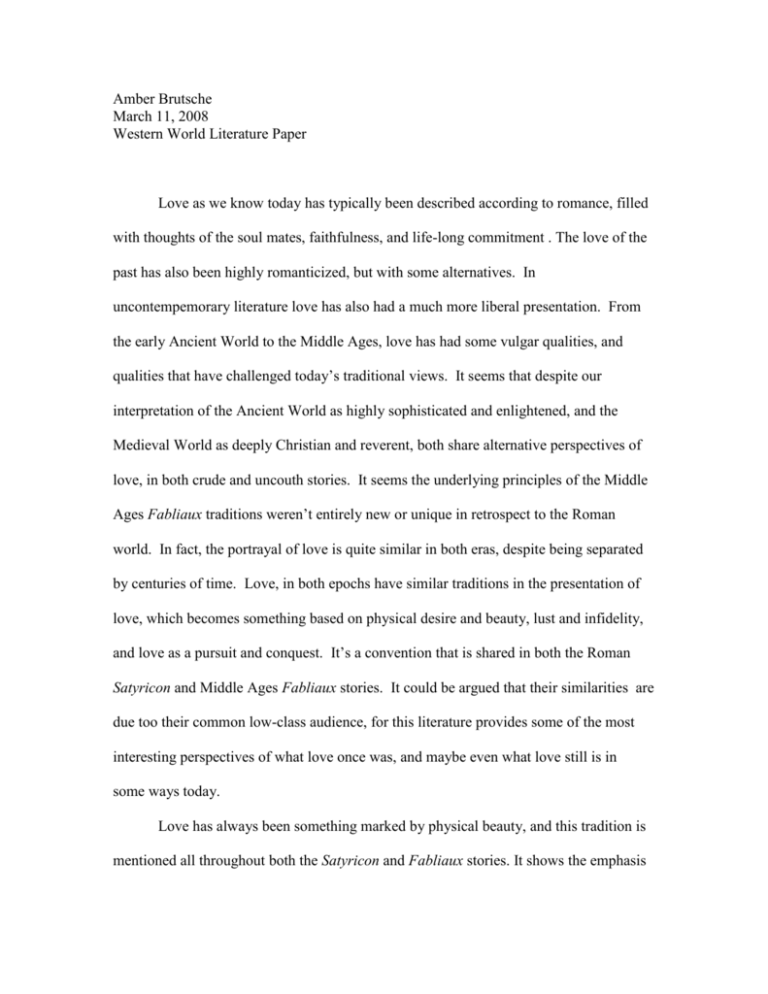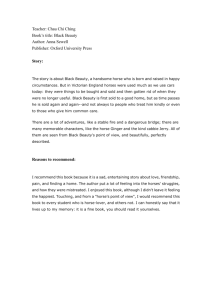
Amber Brutsche
March 11, 2008
Western World Literature Paper
Love as we know today has typically been described according to romance, filled
with thoughts of the soul mates, faithfulness, and life-long commitment . The love of the
past has also been highly romanticized, but with some alternatives. In
uncontempemorary literature love has also had a much more liberal presentation. From
the early Ancient World to the Middle Ages, love has had some vulgar qualities, and
qualities that have challenged today’s traditional views. It seems that despite our
interpretation of the Ancient World as highly sophisticated and enlightened, and the
Medieval World as deeply Christian and reverent, both share alternative perspectives of
love, in both crude and uncouth stories. It seems the underlying principles of the Middle
Ages Fabliaux traditions weren’t entirely new or unique in retrospect to the Roman
world. In fact, the portrayal of love is quite similar in both eras, despite being separated
by centuries of time. Love, in both epochs have similar traditions in the presentation of
love, which becomes something based on physical desire and beauty, lust and infidelity,
and love as a pursuit and conquest. It’s a convention that is shared in both the Roman
Satyricon and Middle Ages Fabliaux stories. It could be argued that their similarities are
due too their common low-class audience, for this literature provides some of the most
interesting perspectives of what love once was, and maybe even what love still is in
some ways today.
Love has always been something marked by physical beauty, and this tradition is
mentioned all throughout both the Satyricon and Fabliaux stories. It shows the emphasis
on physical appeal as a huge aspect of both literary genres presentation of love, and
centers on physical desire and instantaneous attraction. Love, in these two illustrations, is
something that is based on surface, rather than substance, in which looks are key to the
love ignited between two individuals. Love becomes something spontaneous, such as in
the Satyricon, in which a female character named Tryphaena, “fell instantly in love with
the lad”(Chapter 2, Paragraph 4), “the lad” being the young, and very attractive young
man, Giton. The two had only just meet, and yet, “Tryphaena was desperately enamored
of Giton, Giton whole heart was aflamed for Tryphaena” (Chapter 2, Paragraph 5).
Beauty and physical desire kindles the beginning stages of love in this context, for both
the Ancient World and Middle Ages. Outward beauty is essential to being attractive, in
one instance of Petronius’s work, after the narrator Encolpius cuts of his hair and “loses
his beauty”, he is given a wig and makeup to restore his physical appearance. The result
was, “My flaxen wig set off my beauty to advantage, and Lichas, inflamed afresh with
amorousness, began to cast sheeps eyes at me and to solicit favors” (Chapter 14,
Paragraph 3). Once again, physical beauty causes bodily desire and Encolpius is subject
to Lichas instance attraction due to his improved physical appearance.
Physical beauty is prominent all throughout the Satyricon, and is also a strong
point in the Fabliaux tales as well. Beauty is connected the body, and just like in the
Satyricon, becomes attraction based on the surface rather than who the person is due to
their personality or character. Almost every story mentions the object of desire, an
individual as being beautiful or handsome in one way or another, for both genders, but
especially females. In the tale of The Miller and the Two Clerks, the Miller’s young
daughter is described as, “pretty and agreeable, and the miller, lest she be to agreeable,
put her in a bin” (lines 163-165). It reveals there is much to be said about the dangers of
being beautiful because it sparks the lusty-love of other characters, and as the story
reveals, the daughter becomes the object of attraction for one of the clerks. In two of the
stories from day three of the Decameron, physical beauty and instantaneous attraction are
also explored accordingly. In the second novel, a Queen’s groom falls head over heels in
love with his queen and, “became inordinately enamored of her.” In the third novel, from
the female perspective, a married woman falls in love with a gallant, who is described as,
“not yet past middle age,” connecting her physical attraction to his age, and hence his
bodily appearance. In almost every Fabliaux story, beauty is mentioned and essential to
“falling in love.” And with the beginning stage of physical attraction and immediate
desire, comes lust and infidelity, for both the Roman and Medieval literary pieces.
Physical desire sparks fervent lust in both the Satyricon and Fabliaux stories, in
which love becomes a sexual want. Lust also accompanies infidelity in which the
majority of the characters found in both sets of literature are married or involved in a
committed relationship. In the Fabliaux stories, matrimony, monogamy, and faithfulness
are thrown out the window, and most of the tales explore the construction of marriage as
devious and untrustworthy. Take for instance the stories from the Decameron mentioned
above, in the second novel the Queen’s groom manages to sleep with her, despite the fact
she is married to the King. In the third novel, the woman pursues the young gallant
despite the fact she too is married. In fact, in the stories The Butcher of Abbeville and
The Miller and the Two Clerks also explore infidelity and lustful relationships. The
Miller’s wife becomes subject to one of clerk’s tricks and has sexual relations with him,
and in The Butcher of Abbeville, lust is explored a little bit differently because it concerns
a priest and his mistress, however, she too ends up sleeping with someone other than her
committed partner (even though her partner is suppose to be chaste). The Fabliaux
traditions really discourages the idea of faithful and chaste perseveration, for in many
cases, love is specific to lustful, meaningless engagements that are desired because of
physical beauty, but are nothing more than sex and conquest.
The Satyricon also looks at infidelity, and focuses more on sexual promiscuity
and liberal relationships. Unlike the Fabliaux traditions, the Roman literature involves
more than just heterosexual affairs. However, the relationships that take place don’t
follow the patterns of faithfulness and commitment we acknowledge today , and are
much like the Medieval traditions. In the Satyricon, marriage also becomes adulterous,
and on many occasions. For instance, Trimalchio, the rich freed slave of the story, gives
an account about one of his past loves in which he says, “I fell in love with Terentius, the
tavern-keeps wife; you all knew Melissa from Tartentum, the prettiest of pretty
wenches…Well! Her husband dies when they were at country” (Chapter 9, paragraph
11). Trimalchio’s lover was married, and yet he fell in love with her, for her prettiness,
and had the affair despite the fact she was a married woman. Faithfulness also enters in a
little anecdote provided in Chapter 13, in a fable about a woman who was widowed, and
faithfully fasted and stay beside her husband tomb, only to be tempted away by both food
and lust from a solider. To compound the widow’s betrayal, she was willing to desecrate
her husband’s corpse in order to preserve her lover. What most interesting about this
story, is the response of the character Lichas, another victim of infidelity, in which the
narrator mentions, “doubtless he was thinking of the injury done to his own bed”
(Chapter 12, Paragraph 1), a clear remark of his unfaithful wife.
While these examples deal with matrimony, faithfulness is also explored in
homosexual relationships, in which Encolpius, was bitterly betrayed by his male friend
Ascyltos and male lover Giton. Even Giton and Encolpius loving relationship suffers
from lust and infidelity, as both Giton and Encolpius have affairs with others. For
instance, the narrator remarks on the lust shared between Giton and Tryphaena, “I knew
not whether I was more incensed with the boy for having robbed me of my mistress, or
with my mistress for debauching the boy” (Chapter 14, Paragraph 2). Thus, lust and
infidelity are common elements to the tradition of love, and reveal love as a physical,
passionate, and impulsive conquest for many individuals.
While love begins with physical attraction and is acted on through lustful and
often adulterous circumstances, the way love concludes in both literary genres is the most
intriguing. Love is a conquest, one that is pursued through lust and sexual relations, and
often only to be a temporary infatuation. For many of the characters, in both pieces of
literature, they are involved in passionate pursuits or being passionately pursued by
another character because they are “in love”, and once they satisfied their “love” the
relationship ends. In most instances, the relationship is nothing more than sex, and the
characters move on to another pursuit. In the very beginning of The Satyricon, the love
shared between Tryphaena is brief, Tryphaena pursues Giton and, “after draining him or
his strength, was openly neglecting him” (Chapter 2, Paragraph 9). Just as quickly as the
love began, it is over once Tryphaena has fulfilled her desire. It’s a theme that is also
seen in Encolpius experiences with Circe (Chapter 15). Circe pursues Encolpius, only to
find he is unable to fulfill his duty and fulfill her desire. The result, and the failure of the
conquest is monumental, and causes huge conflict for both characters, both enraging
Circe and leading Encolpius think himself cursed. It reveals that love is a physical act,
and that the sexual, lustful nature of love is what is most emphasized. The way love
changes and starts and ends in the Satyricon shows love is a impulsive pursuit, and
sought by temperamental characters who love many different individuals all throughout
the story.
The Fabliaux also reveals the idea of pursuit and conquest, but to an even greater
extreme. In almost all the tales, the lead protagonist(s) will outwit another individual in
order to successfully sleep with someone. In the forth and eight stories of the Decameron
from day three, the characters of Don Felice and the Abbot are fruitful in their pursuits of
the married wives and have sex with them while their husbands are foolishly engaged in a
some trick propose by the “hero”. By deploying their tricks, such as forty days of
abstinence and prayer or many months of drugged time in purgatory, they are able to
successfully pursue the women they desire, and profit from their efforts. In the Butcher
of Abbeville, the conquest is apparent as the butcher sleeps with the mistress, and “when
he had fulfilled his desire, He went way; he would stay no longer” (lines 294-295).
Humorously in the tenth story of the Decameron from day three, one man fulfilled his
conquest of “putting the devil in hell” and was faced with this response by the girl,
“Rustico, if thy Devil is chastened and gives thee no more trouble, my hell on the other
hand, gives me no peace”. Thus, the conquest is usually one sided, and the love may not
be over for one of the characters, even through the other has fulfilled their desire and
want. These are just a few examples of the many Fabliaux traditions, but they share the
same theme of love as being short-lived, and usually encompassing the idea of love as
sex, and once the event takes place, the love (if it ever truly existed) fades away.
So both Roman and Medieval traditions share similar ideals of love, especially
concerning aspects beauty, lust, desire, adultery, infidelity, substance, and honor. And
while this pieces of literature are very similar, not all literature from these eras share such
a corrupt view of love. The reasons why the Satyricon and the Fabliaux traditions are so
complimentary could be argued as due to their audiences, and the idea they aren’t what
common culture considers, “high-brown literature”. Its seems in their style, tone, and
brazenness, both genres fit into the lower-classed audiences, especially since they have
other themes and critiques of the social world, such as making fun of nobility, wealth,
religion, and the upper classes. They also seem to provide a much more realistic light
into the idea of love, rather than idealizing it as perfect and idyllic, these stories show it
for what can be sometimes. Love is connected to lust, and desire, and want, and those
aspects, although greatly exaggerated in some instances, are realistically illustrated in
The Satyricon and the Fabliaux tales.
In the end, we have two forms of literature, separated by hundreds of years of
history and human evolution, and yet they are profoundly similar. They are similar,
because humanity, despite its evolution still has concrete characteristics of behavior and
thought. Love, can be presented both ideally and satirically, however there is truth in
both. Love and especially the lust that derives from it can serve as way to construct and
critique the social world and people no matter what time frame. In some respects, the
loves described in these literary genres are not so different from what we know today.
We may hold a view of traditional, romantic, and picturesque love however elements of
love at first sight, cheating and extramarital affairs, meaningless pursuits and one night
stands aren’t so unheard of now. The Ancient world, the Middle Ages, even our
American culture today continues to explore the idea of love in literature, and yet we still
share a similar understandings in out portrayal of “love”.











